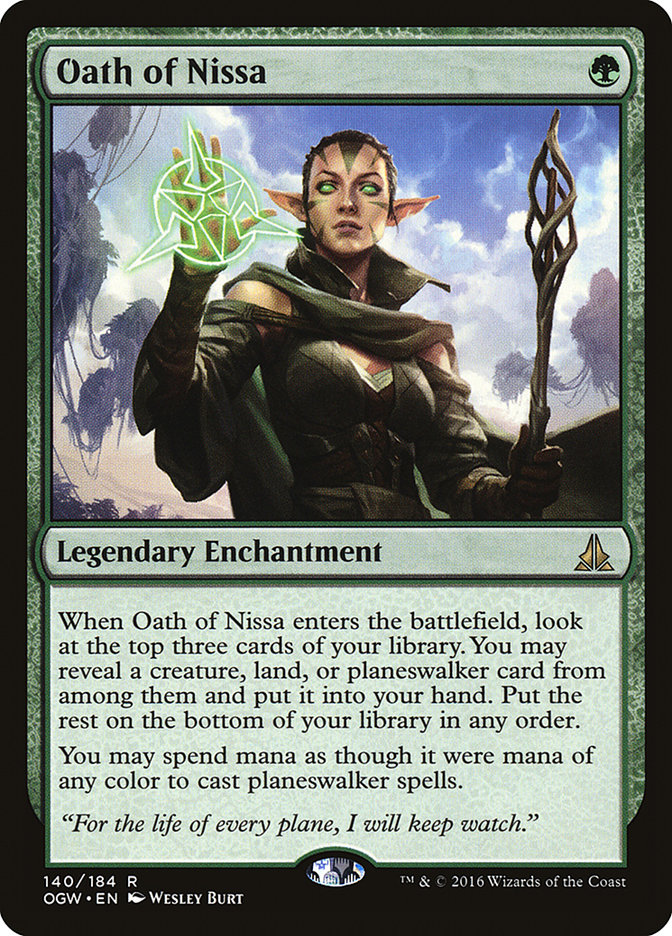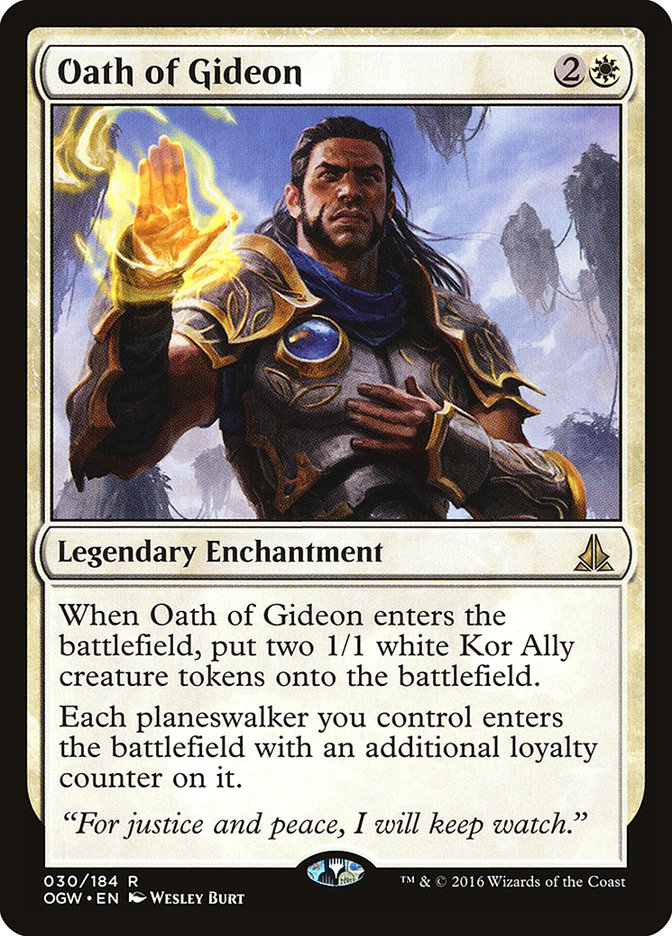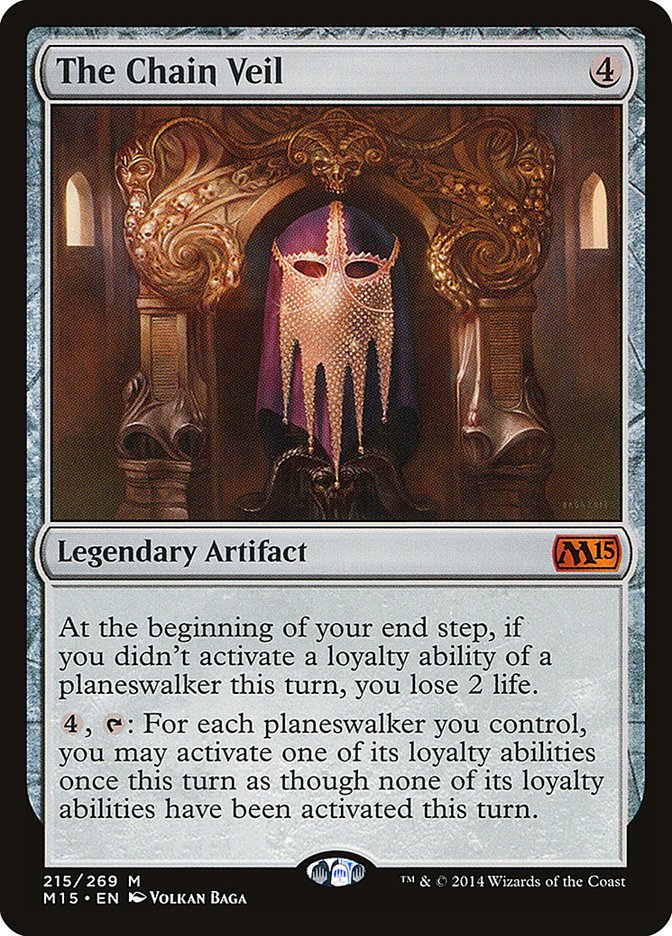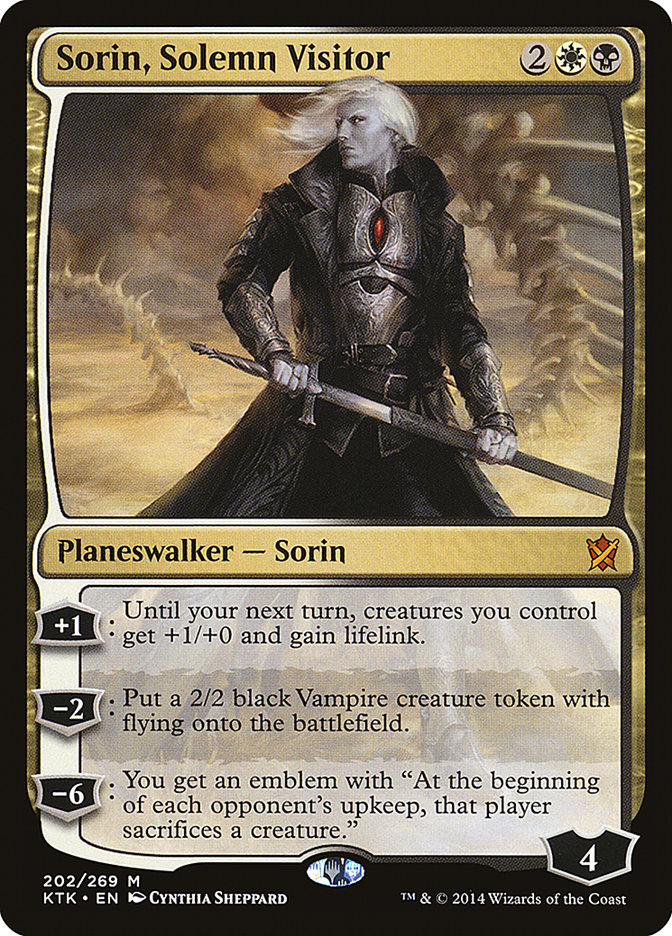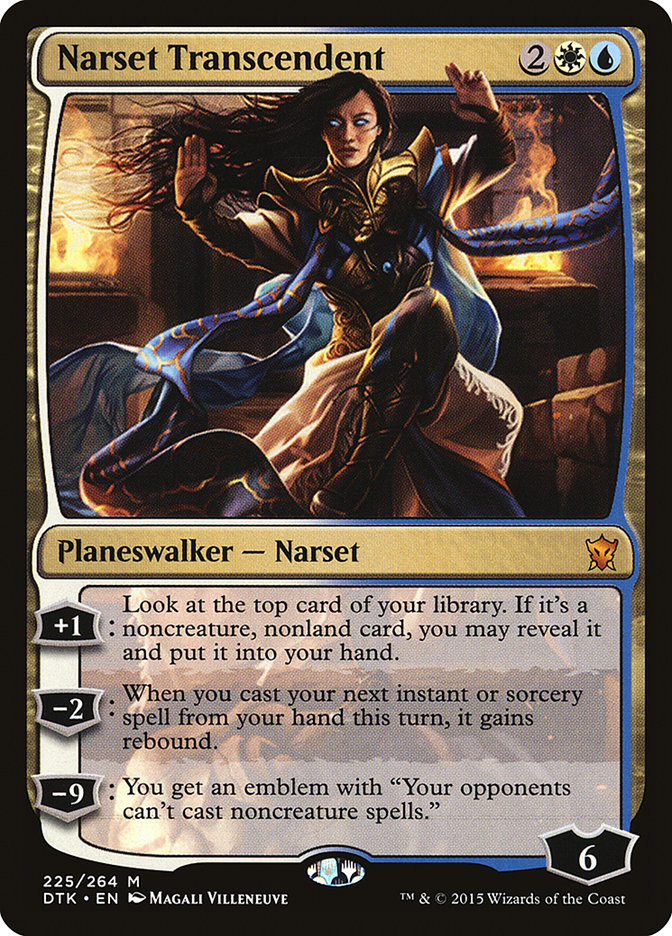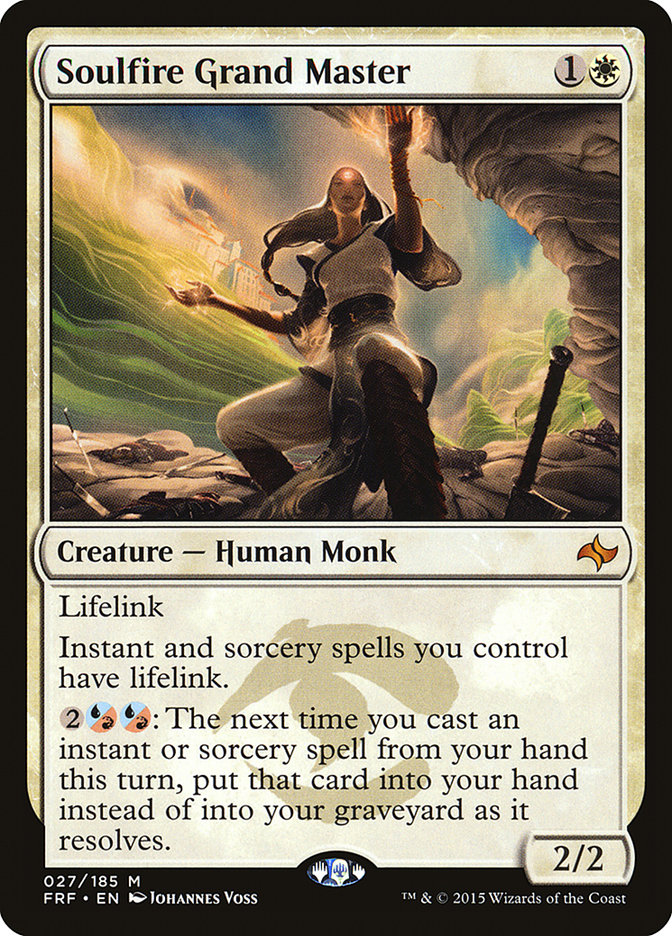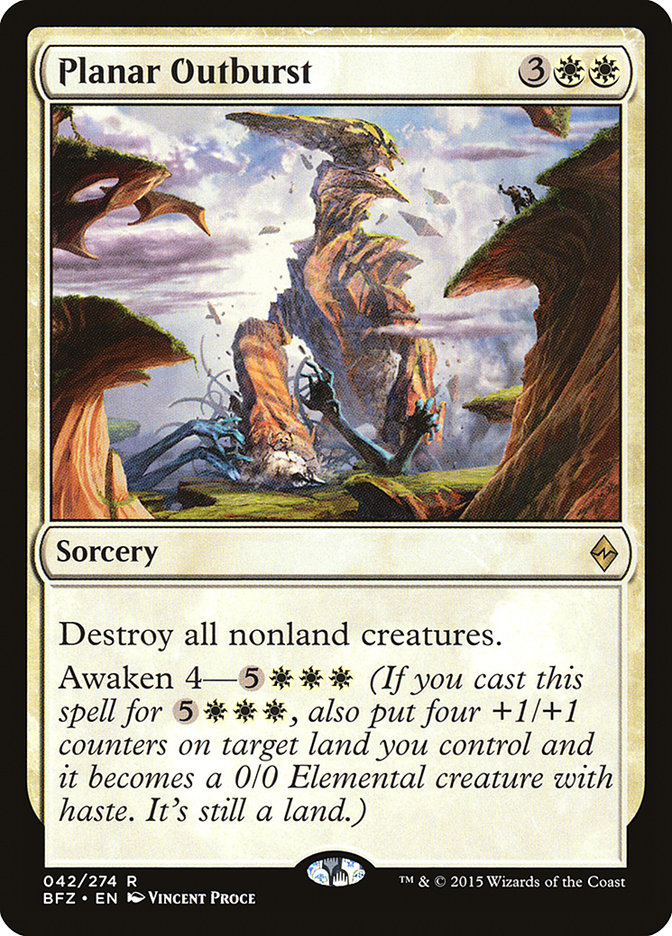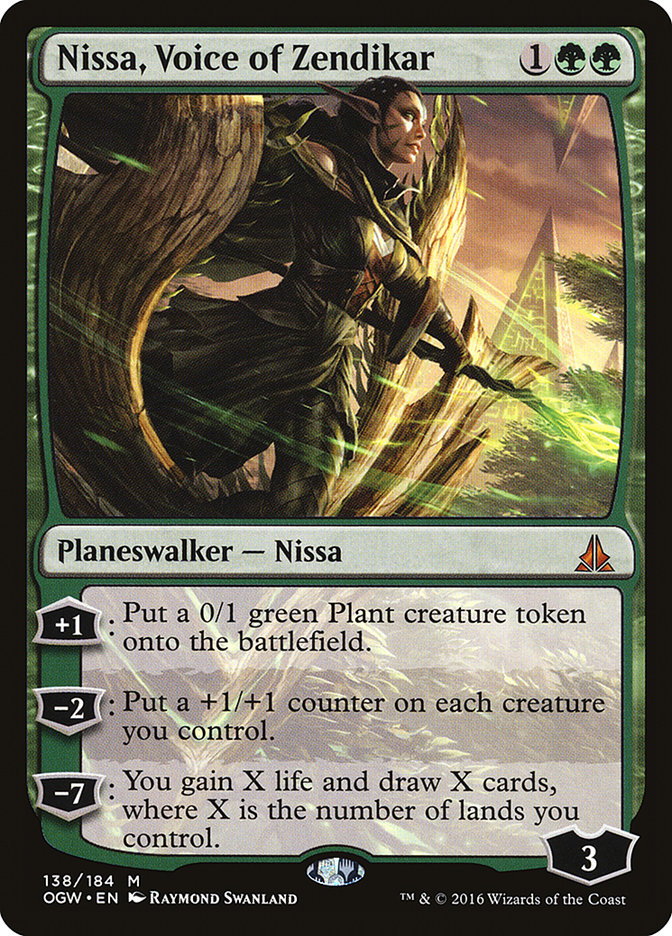Card cycles are like boy bands: sure, they’re all pretty, talented, and marketable, but one always stands out.
See also: Harry Styles.
This has always been the case with cycles. Even the original “boon” cycle from two decades past has this ailment. Ancestral Recall and Dark Ritual changed the way the game works, Lightning Bolt and Giant Growth have been integral in the formats in which they’ve been printed, and Healing Salve? Bet you didn’t even remember what it did without mousing over it (I’d forgotten.)
Oath of the Gatewatch has a somewhat off-kilter cycle in its eponymous Oaths, missing a corresponding black enchantment. Out of the four members of this band, Oath of Nissa is the only one seeing any amount of play, the only one who commands any sort of clout in a trade, and the only one we’re not going to talk about today.
Instead, let’s look at what I believe to be the most proactive, and my personal favorite, of the four Oaths. Oath of Gideon does a lot of things, and it’s a lot more multi-faceted than it first appears. As is the case with every Oath, though, their most novel ability has to do with the way they interact with planeswalkers.
Only a few cards have interacted with a planeswalker’s ability to add loyalty counters, one rather infamously. Cards like The Chain Veil have appeared with a splash, and then disappeared, mostly because the cost and penalty are far too high.
Oath of Gideon bypasses both by being all upside, and providing an immediate bonus, whether or not you ever cast a planeswalker. Unlike the planeswalkers-matters cards of the past, the Oath cycle is playable in most every instance that can find a use for any of its modes.
For these first two decks, though, we’ll focus on just this aspect.
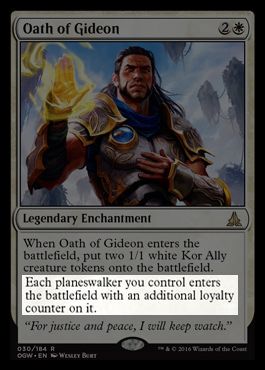
Starting with one more loyalty counter means you can use a planeswalker’s negative loyalty ability more efficiently, earlier, and, in many cases, more times. Starting with an extra counter also makes planeswalkers more durable. Finally, the more counters you start with, the sooner you can use a planeswalker’s ultimate ability.
So with a focus on ultimating a planeswalker, which planeswalkers seem to take the most advantage of this ability?
Naturally, as is the cast with most Oaths, they work particularly well with the planeswalker who took that Oath. Gideon can enter the battlefield, create an emblem, and survive to churn out 3/3 Knight Ally tokens for as long as you can protect him, giving you a sturdy plan. This is the most obvious and most explored path of Oath of Gideon.
Sorin, Solemn Visitor is almost more exciting. With just one positive activation after you cast him on-curve, you’re ready to ultimate him. Your opponent must respond or suffer under the weight of losing a creature every turn for the rest of the game. That’s a turn 5 ultimate, and assuming they haven’t died to other spells or combat, you’ll be able to defend him with two 2/1 Kor Ally tokens. If we’re white and black, Ob Nixilis Reignited would stand to reason as a notable addition, despite the flavor fail. With Oath of Gideon, he can enter, kill a creature, and then after you untap, he can kill another creature without the awkward phase of +1’ing in the middle when you really just need something dead. Liliana is on-color, too, and bringing her in with an extra counter lets you get her party started earlier, too.
Let’s look into a list that runs these four planeswalkers!
Creatures (9)
Planeswalkers (6)
Lands (25)
Spells (20)

This is an old-fashioned control deck with a critical mass of removal, threats, and inevitability that have the potential to close a game and stay alive. Seeker of the Way is a lift straight from Jeff Hoogland’s playbook; with so much removal, you can bring tempo to your control game, padding your life total to take a beating as you lose tempo other places. Hangarback Walker is a great way to spend your off-turns or to tie up a loose mana each turn. Liliana, Heretical Healer, while she does not have many targets, insta-flips off Hangarback Walker for zero. She works great with the two targets she has, especially with Gideon’s emblem. You can bring a Hangar-back for zero loyalty each turn, slowly building it back up to give Thopters again.
Four copies of Oath of Gideon seem essential if we want to live the curve dream: Seeker, Oath, Gideon, and Ob Nixilis. The planeswalkers themselves are much sturdier with the Oath’s help, and it helps them be relevant more quickly and for longer, something I think planeswalkers need to be important in this format. Two of each seems just about right, though a third Gideon or Sorin might be preferred.
The removal suite is intense, providing efficient, hard removal that doesn’t leave much wiggle room. I’m fine with Immolating Glare in this Standard; I’m not too worried about removing blockers when I can kill them with other spells or I can smash through them with Gideon, Ally of Zendikar or I can avoid them altogether with Thopters. Moreover, Immolating Glare on an attacking Hangarback Walker is a fun way to break it in response to an Abzan Charm.
This is a revision of my first draft of an Oath of Gideon deck. I took more of a prototype to an FNM and beat Mardu Green, Ramp, Jeskai Black, and Goblins with it. Despite its success, it had some glaring holes in it; at the time, I played too few removal spells and not enough draw. I cut creatures and added more interaction, which in practice, made the deck run much more smoothly.
In a telling game against Grixis Prowess, I stuck an early Sorin emblem and thought I had the game on lock. Despite my opponent sacrificing a creature every turn, the combination of haste creatures and Treasure Cruise kept him fighting; the deck had too little instant-speed removal and pressure to handle the onslaught, and soon I was dead, despite my best attempts to stop him. The tweaks I made after this FNM led to the list you see.
I was happy with the deck, but I wanted more copies of Oath of Gideon. Maybe just white and black wasn’t thinking deep enough. Lots of great planeswalkers can benefit from the extra counter! With paper, pen, and the dream to afford my next list, I jotted down what my mind tried to conjure.
The other multicolored white planeswalker, Narset Transcendant, has an emblem that makes Sorin’s look like child’s play. Completely eliminating removal, counterspells, library manipulation, planeswalkers, and ramp from an opponent’s repertoire is a quick way to a game where you can do whatever you want without interference.
Blue also brings us the format’s boogeyman, Jace, Vryn’s Prodigy. On the back of all this money these mighty planeswalkers, how can we lose?
Creatures (10)
Planeswalkers (6)
Lands (27)
Spells (17)
- 2 Dig Through Time
- 2 Valorous Stance
- 2 Ojutai's Command
- 1 Roast
- 2 Gideon's Reproach
- 4 Planar Outburst
- 1 Oath of Jace
- 2 Oath of Gideon
- 1 Oath of Chandra
Sideboard

In this Jeskai-hued build, we’re creating a battlefield state where creatures don’t matter and we’ll be able to outdo our opponents with the planeswalkers and noncreature permanents we resolve. Jace is, well, Jace. Seeker of the Way gets another shot here along with its Jeskai buddy, Soulfire Grand Master. Most of the spells are inexpensive, which are easy to rebuy, and several deal damage to creatures, making the “lifelink” clause happy.
The planeswalkers follow a similar pattern from the previous deck: two of each. Chandra, Flamecaller gives more incentive to add the third color, and she can sweep the battlefield, too. The bump from four damage to five damage if you have Oath of Gideon out is no small thing; it can then clear Reality Smasher, Siege Rhino, Sylvan Advocate, and Linvala, the Preserver. Or, she can sweep for four and survive to start churning out new hands or Elementals for you.
Narset’s plus ability hits off twenty-three cards in the deck, but in this day and age, that number can’t very realistically be much bigger. Even though she’s a less-than-even-chance hit on her plus, she will then have effectively eight counters with an Oath of Gideon. One more turn and she’s ready for a turn 6 ultimate, utterly locking most players out of a game of Magic.
This deck features Oath of Jace, a convenient way to get Jace flipped on turn 3 (fetch twice, discard two on turn 3 with the Oath, tap, and flip Jace.) If they’ve got a slow start, you’ve basically got a Thassa, God of the Sea that can do way more. Oath of Gideon is in a lesser quantity, but we have more library manipulation now, so we can get one when we need it or toss it when we don’t. Oath of Chandra, especially with the prospect of flipping planeswalkers, provides another bit of inevitability. In theory, if you cast every planeswalker in the deck with an Oath of Chandra out, that’d be exactly lethal.
Planar Outburst is not only one of the most unconditional sweepers in the format, it’s awesome with Narset, who can rebound it on-curve to keep the battlefield utterly clear for two turns. Four is a lot, but if you can survive to five mana, this is by far the format’s most powerful and inclusive removal spell. Late in the game, it can provide you a win condition, too, especially when slapped on a Needle Spires! Ojutai’s Command can recover any creature in the maindeck and sideboard, and every mode has the potential to be helpful to this deck.
This is fun! What else can Oath of Gideon do?
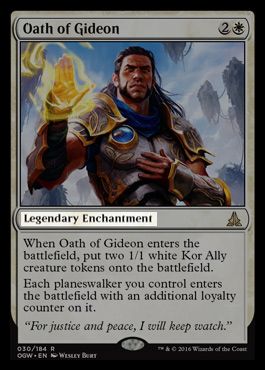
It is an enchantment, which is a card type I’m always enchanted by interested in. Herald of Pantheon is just as fun as any reducer, and pushing the fact that this is not only an enchantment, but a legendary enchantment, seems to suggest a fun time. A deck with green will likely include Harry Styles Oath of Nissa, but we can still have a fun time!
Creatures (12)
Planeswalkers (4)
Lands (26)
Spells (18)

This list explains itself a little better than the others, but Herald of the Pantheon and Rattleclaw Mystic propel us into our planeswalkers and enchantments. Nissa, Vastwood Seer gets planeswalker benefits, and she helps find a land to keep up with Mina and Denn, Wildborn, a duo I gleefully covered a few weeks ago for their potential. Double landfall triggers work great with our Retreats, and because I need less land to play them thanks to the aforementioned cost reducers, I’ll be more likely to cast and use them the same turn.
Gideon and Chandra return, awesome as ever, but I didn’t like Nissa, Voice of Zendikar for this deck as much; she needs a lot of creatures for her -2 ability to be solid. Chandra is even faster with the deck’s mana ramp. In this enchantment deck, we’ve moved to three each of our signature Oaths. Oath of Nissa has 42 targets in this deck, which means we’ll often have a choice in what we take. The fact that they’re legendary will come up in a moment.
Silkwrap and Stasis Snare are our format’s Journey to Nowhere, and you can’t live in Standard these days without removal. The four Retreats allow you to both make and empower tokens and armies of tokens. They will actually close the game for you. The real ringer is Starfield of Nyx. Thanks to the legendary clause on each Oath, copies can’t exist on the battlefield together. However, when they enter the battlefield, they have a special trigger. In the Oaths’ case, this can be rebought at every upkeep, whether it’s two Ally tokens or drawing a relevant card, you’ll get a special effect every turn, plus you’ll be able to get them sideways if you develop an overwhelming battlefield presence.
One more Oath of Gideon mode!
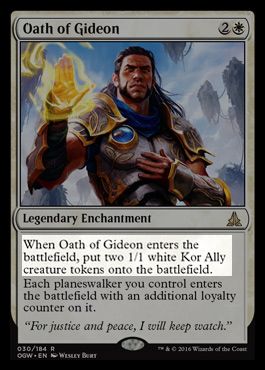
Oath of Gideon makes two tokens, but they’re not just any tokens: they’re Ally tokens! Allies have lots of support, but they’ve been looking for the right shell for a long time. Could this be one of them?
Creatures (18)
- 4 Seeker of the Way
- 2 Pia and Kiran Nalaar
- 1 Munda, Ambush Leader
- 2 Reckless Bushwhacker
- 4 Stone Haven Outfitter
- 4 Weapons Trainer
- 1 Stoneforge Acolyte
Planeswalkers (4)
Lands (25)
Spells (13)

This is a retooling of the first deck I made for Oath of the Gatewatch Standard, and it plays way better. Arm yourselves! Red and white always lend themselves to aggro builds, but this tones down the hyper-aggression in favor of an improved draw step and power level. An even balance of spells and creatures help us create a variety of situations where our Allies can attack consistently. Combined with Stone Haven Outfitter, Weapons Trainer, and an emblem from Gideon, Ally of Zendikar, our team can get surprisingly large.
Pia and Kiran Nalaar, while not Allies, work well with Gideon’s emblem or Weapons Trainer’s attack boost. Reckless Bushwhacker was a late addition, as some testing proved finishing the opponent was a problem and haste was a good way to solve that. Exquisite Firecraft also helps and is the most flexible removal before sideboard.
I did actually build and test this one and found it to be soft to midrange decks with efficient removal, but it was fun and powerful enough to warrant a revisit after all these four-color good-stuff decks disappear with the passing of fetchlands.
Who’s your favorite member of the Oath band? Does Oath of Nissa win your heart, or does Oath of Jace beguile you to its side? Maybe you’re a Gideon kid like me, or are you fond of Chandra’s Oath? Have you been able to find a fun and innovative way to fashion your passion?


